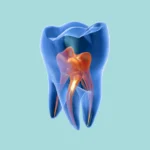Picture this, Doctor: you’re getting ready for a routine root canal on a lower molar. The case seems straightforward, even simple. You take a pre-operative X-ray to get a clear view, and suddenly, the tooth’s internal anatomy looks incredibly unusual. The pulp chamber appears abnormally large and expansive, while the roots are remarkably short, almost as if the tooth lacks a distinct “neck.”
If that scenario sounds familiar, you’re likely observing a case of Taurodontism. There’s no need for alarm, but recognizing this condition is critical because it can completely alter your treatment approach.
What Exactly is Taurodontism?
So, what exactly is Taurodontism? In simple terms, Doctor, it’s a specific type of dental anomaly. It’s characterized by a noticeably elongated tooth body and an extended pulp chamber, combined with roots that are significantly shorter than what’s typical for multi-rooted teeth.
How to Spot it: Radiographic Features
To catch it quickly on a radiograph, your eye needs to be trained to spot these specific details:
Location
While it’s most frequently observed in mandibular molars, taurodontism can affect any multi-rooted tooth.
The Edges
The tooth’s external borders will appear distinctly well-defined.
Overall Shape
-
The tooth body itself looks notably elongated.
-
The roots are conspicuously shortened.
-
Crucially, the crown’s external size and morphology remain completely normal.
Internal Structure
-
The tooth presents as radiopaque, mirroring the density of normal tooth structure.
-
The most telling sign, however, is the significantly enlarged and expansive pulp chamber.
Number of Affected Teeth
It can manifest in a single tooth (single) or affect multiple teeth (multiple).
Key Points About Taurodontism
-
The term itself originates from the Greek ‘tauros’ meaning ‘bull’ and ‘odont’ meaning ‘tooth,’ because its distinct shape resembles the teeth of cattle.
-
As noted earlier, the external crown morphology appears entirely normal in both size and shape.
-
The crucial bifurcation or trifurcation point of the roots is positioned much closer to the apex than typical.
Why Clinical Awareness Matters (Clinical Significance)
Recognizing this condition is profoundly important in clinical practice for several key reasons:
-
It can significantly complicate endodontic treatment due to the highly altered pulp chamber anatomy.
-
There are potential challenges during tooth extraction, given the unique root morphology.
-
Typically, it does not adversely affect the overall function of the tooth.
-
Occasionally, taurodontism is associated with certain systemic conditions or syndromes, such as Klinefelter’s syndrome.
A Final Note
One final point to keep in mind, Doctor: the severity of taurodontism can vary considerably, ranging from mild to very severe presentations. The definitive diagnosis relies primarily on a thorough radiographic examination.



















